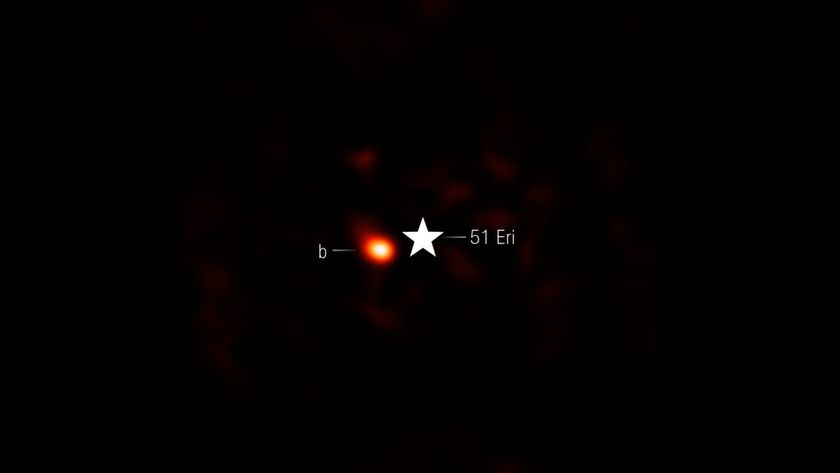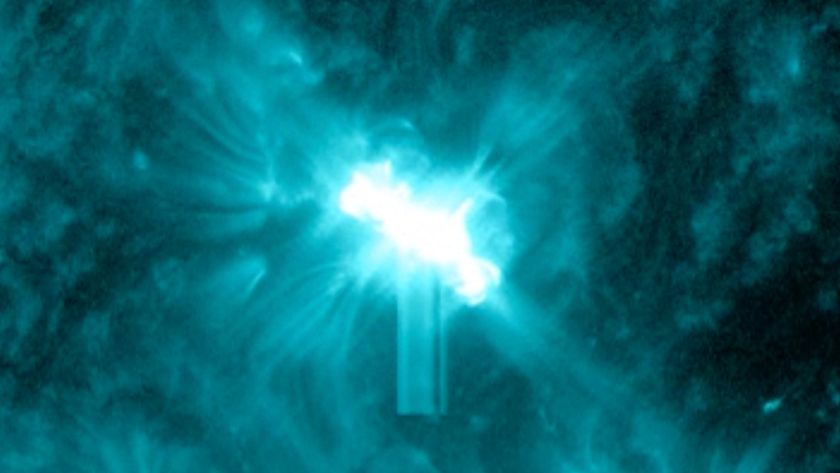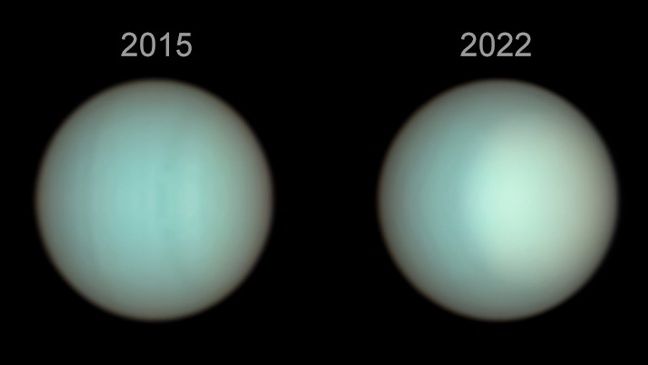This week, the giant planet Jupiter, poised against thestars of Sagittarius, looms up into view low in the southeast in the middle ofthe night. It rises around 11:30 p.m. local daylight time, and is best seen intelescopes just before morning twilight, when it's fairly high in the south orsoutheast. A medium-size telescope of high quality on a night of good seeingwill show the disk of this creamy white giant richly, though subtly patterned.
Anyone who points a small telescope toward the planetJupiter will nearly always see some or all of the four famous "Galilean"satellites, first seen by Galileo in 1610. Usually at least two or three ofthese big moons are immediately evident, sometimes all four. They appear astiny stars in small telescopes and even steadily-held binoculars.
Conversely, it is rather unusual when only one moon is inview and rarer still when no moons at all are visible, as will occur next weekfor skywatchers in select locations in Eastern North America. On such occasionswhen all four are simultaneously invisible is it because:
- They are passing across the disk of Jupiter (in transit),
- They are behind Jupiter (in occultation) or
- They are within Jupiter's shadow (in eclipse).
Historical perspective
The first-ever recorded observation of Jupiter "Withouta Visible Satellite" was apparently made in 1681. Writing about this loneepisode in his book, A Cycle of Celestial Objects, in 1844, William Henry Smythcommented that this was "... a conjunction which will require more thanthree thousand billions of years to occur again."
Smyth's estimate, however, was a humongous exaggeration. Whilesuch "moonless" occasions are indeed rare, they actually occur about20 times per century. Gian Vincenzo "Enzo" Mora of Sequals, Italy made the first extensive calculation of Jupiter's moonless occurrences in 1909. Hislisting, obviously intended to be exhaustive, spanned the entire 19th and 20thcenturies. The studies of Mora were meticulous, and no doubt required atremendous amount of time, and all without the aid of modern computers!
Modern studies, using computer technology have demonstratedthat Mora's computations were incredibly accurate, although he did overlookthree occasions (in 1859, 1895 and 1962) when Jupiter appeared withoutsatellites.
Get the Space.com Newsletter
Breaking space news, the latest updates on rocket launches, skywatching events and more!
A new set of predictions was recently drawn up by thewell-known Belgian astronomical calculator, Jean Meeus, for the period from1900 to 2100 AD. And as it turns out, one of those opportunities to see Jupiterwith no moons is presented this week.
Tough to see!
This upcoming event will coming during the late eveninghours of Wednesday, May 21, but unfortunately will be only be visible along theEastern Seaboard of the United States, as well as the Canadian Maritimeprovinces. Even in these locations, visibility will be a challenge, for the "moonlessinterval" will begin only minutes after Jupiter rises and it will onlylast 19 minutes! Farther to the west, across the rest of the United States and Canada, at least a couple of the moons will have already emerged into view by thetime Jupiter rises.
At 11:50 p.m. Eastern Daylight Time on May 21 (or 12:50 a.m.Atlantic Daylight Time on Thursday, May 22), the situation in regard to thefour satellites will be as follows:
- Io, the innermost Galilean moon, will become eclipsed by Jupiter's shadow.
- Europa will be in transit, passing across Jupiter's disk.
- Ganymede will be out of view behind Jupiter's disk in occultation.
- Callisto, the outermost moon, like Io, will also be in eclipse. Io will be the last to disappear.
Then, 19 minutes later, at 12:09 a.m. EDT on May 22 (1:09a.m. Atlantic Daylight Time), Ganymede will emerge from behind Jupiter.
For those living along the immediate US East Coast, Jupiterwill be very low at that time ? depending on your location ? only about 3 to 6 degreesabove the east-southeast horizon. This means having to view Jupiter through theperpetual haze layer lying near to the horizon. Its brilliance will almostcertainly be attenuated, and its image is likely to appear as if it were "boiling"or fuzzy as you gaze at it through our turbulent atmosphere. Nonetheless, itmight still be worth a try.
In contrast, a much better view will be available from the Caribbean. From San Juan, for instance, Jupiter will stand more than 20 degrees above thehorizon when all four moons are out of sight (your clenched fist held at arm'slength measures 10 degrees). And much of South America will also see Jupiterwell above the horizon when the Galilean satellites vanish.
Another (much better) chance
If you miss out seeing Jupiter without satellites, you canat least be consoled in knowing that there will be another, much better chance lessthan 16 months from now, on the night of September 2-3, 2009. That event willtake place in the middle of the night for North America, with Jupiter appearingwell up in the southern sky. And best of all, the four moons will be out ofsight for almost two hours.
- Online Sky Maps and More
- Sky Calendar & Moon Phases
- Astrophotography 101
Joe Rao serves as an instructor and guest lecturer at New York's Hayden Planetarium. He writes about astronomy for The New York Times and otherpublications, and he is also an on-camera meteorologist for News 12 Westchester, New York.
Join our Space Forums to keep talking space on the latest missions, night sky and more! And if you have a news tip, correction or comment, let us know at: community@space.com.

Joe Rao is Space.com's skywatching columnist, as well as a veteran meteorologist and eclipse chaser who also serves as an instructor and guest lecturer at New York's Hayden Planetarium. He writes about astronomy for Natural History magazine, Sky & Telescope and other publications. Joe is an 8-time Emmy-nominated meteorologist who served the Putnam Valley region of New York for over 21 years. You can find him on Twitter and YouTube tracking lunar and solar eclipses, meteor showers and more. To find out Joe's latest project, visit him on Twitter.











